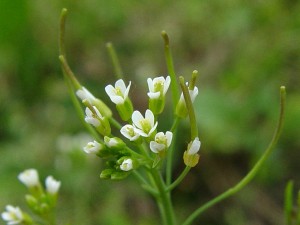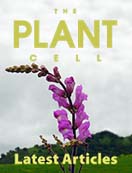Researchers at Purdue University have discovered a genetic mutation that allows a plant to better endure drought conditions without losing biomass. This discovery could prove significant because it could lead to plants that need less water to survive and thrive despite adverse climatic conditions.
Mike Mickelbart, an assistant professor of horticulture; Mike Hasegawa, a professor of horticulture; and Chal Yul Yoo, a horticulture  graduate student, found that a genetic mutation in the research plant Arabidopsis thaliana reduces the number of stomata. Stomata are important because they are pores that take in carbon dioxide and release water. During drought conditions, a plant might close its stomata to conserve water. However, by doing this, the plant also reduces the amount of CO2 it can take in which limits photosynthesis and growth. But in the stomata of the mutated plants, instead of limiting CO2 intake, the gene creates a beneficial equilibrium.
graduate student, found that a genetic mutation in the research plant Arabidopsis thaliana reduces the number of stomata. Stomata are important because they are pores that take in carbon dioxide and release water. During drought conditions, a plant might close its stomata to conserve water. However, by doing this, the plant also reduces the amount of CO2 it can take in which limits photosynthesis and growth. But in the stomata of the mutated plants, instead of limiting CO2 intake, the gene creates a beneficial equilibrium.
“The plant can only fix so much carbon dioxide. The fewer stomata still allow for the same amount of carbon dioxide intake as a wild type while conserving water,” said Mickelbart, whose results were published in the early online version of the journal The Plant Cell. “This shows there is potential to reduce transpiration without a yield penalty.”
According to a news release, Mickelbart and Yoo used an infrared gas analyzer to determine the amount of CO2 taken in and water lost in the Arabidopsis mutant. CO2 is pumped into a chamber with the plant and the analyzer measures the amount left after a plant has started to take up the gas. A similar process measures water lost through transpiration, in which water is released from a plant’s leaves.
 Analysis showed that the plant, which has a mutant form of the gene GTL1, did not reduce CO2 intake but did have a 20 percent reduction in transpiration. The plant had the same biomass as a wild type of Arabidopsis when its shoot dry weight was measured.
Analysis showed that the plant, which has a mutant form of the gene GTL1, did not reduce CO2 intake but did have a 20 percent reduction in transpiration. The plant had the same biomass as a wild type of Arabidopsis when its shoot dry weight was measured.
“The decrease in transpiration leads to increased drought tolerance in the mutant plants,” Yoo said. “They will hold more water in their leaves during drought stress.”
Of the 20 genes known to control stomata, SDD1, which is a gene responsible for regulating the number of stomata on leaves, was highly expressed in the mutant. Whereas in the mutant, with GTL1 not functioning, SDD1 is highly expressed, which results in the development of fewer stomata.
Mickelbart said the finding is important because it opens the possibility that there is a natural way to improve crop drought tolerance without decreasing biomass or yield. The next step in the research is to determine the role of GTL1 in a crop plant such as corn.

